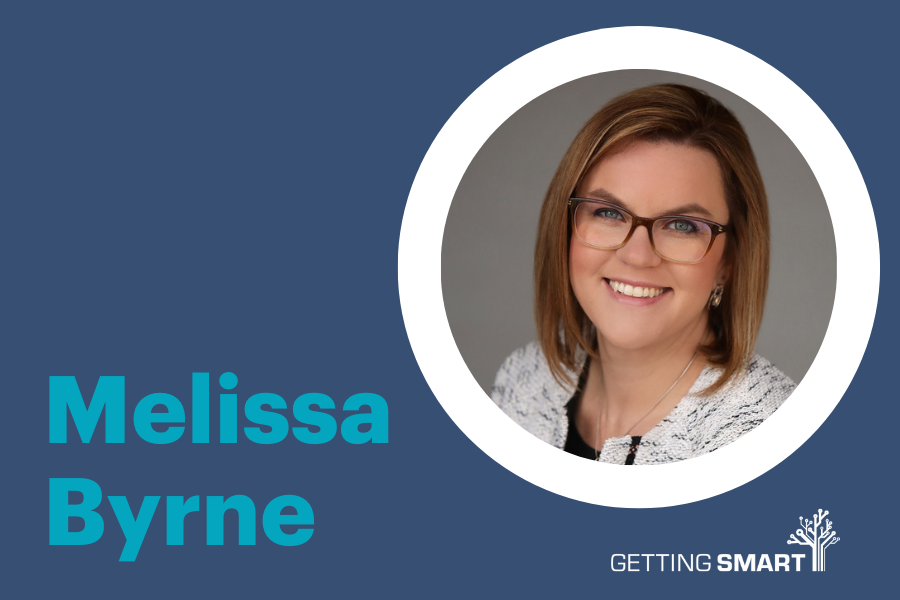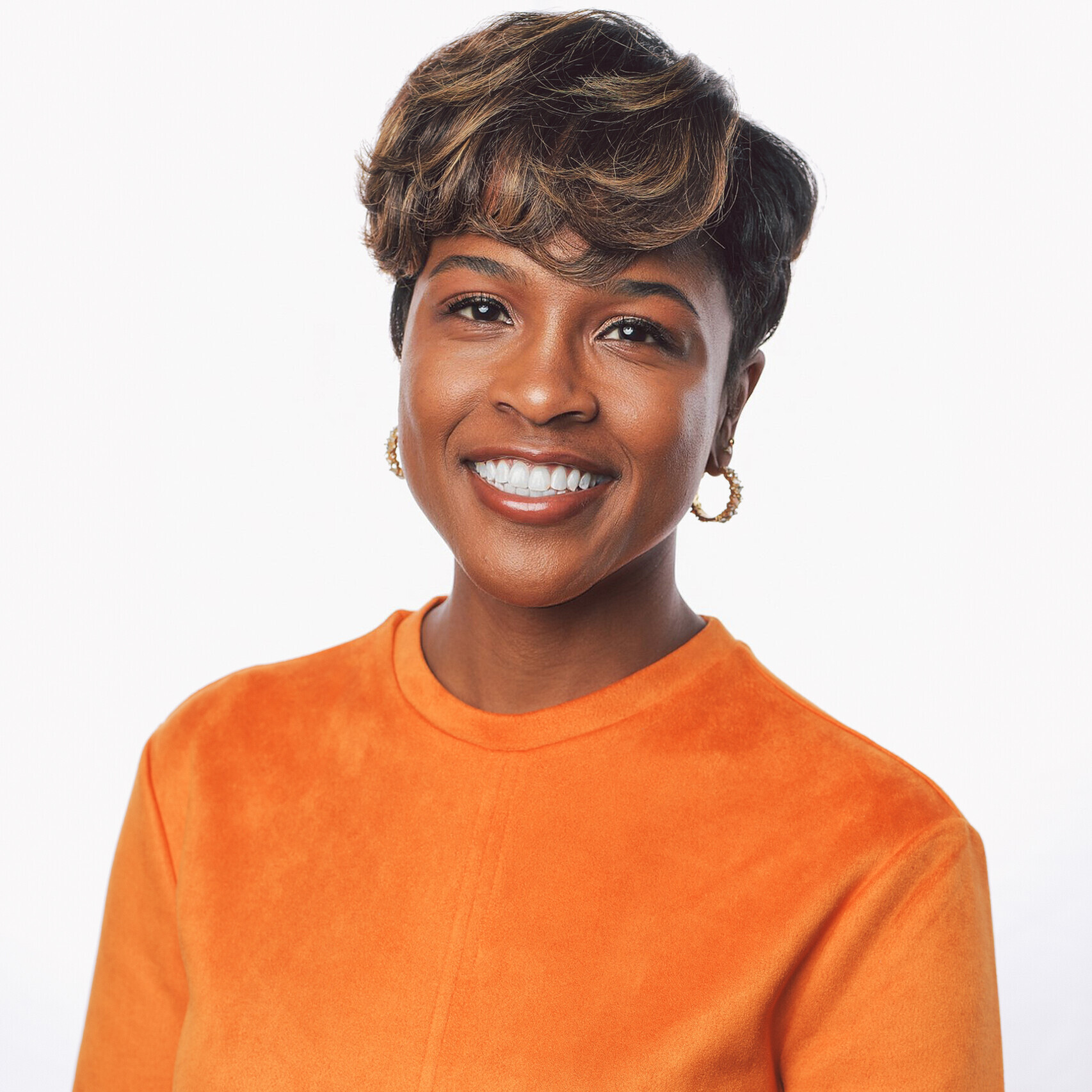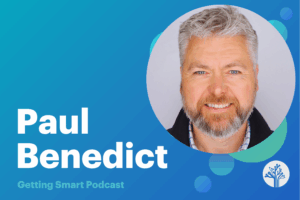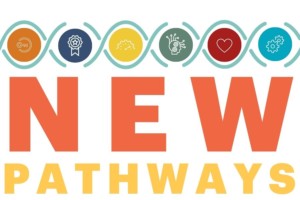Melissa Byrne on Connecting a Learner Profile to Pathways and Postsecondary Workforce Readiness
Key Points
-
Barrington 220 School District’s innovative approach leverages partnerships with community colleges and local industries. This model provides students with real-world learning opportunities and prepares them for post-secondary success.

This episode of the Getting Smart Podcast is sponsored by Mrs. Wordsmith, learn more at mrswordsmith.com
On this episode of the Getting Smart Podcast Victoria Andrews is joined by Melissa Byrne, Assistant Superintendent of Teaching & Learning at Barrington Community 220 School District in Illinois. Getting Smart visited Barrington High School a few weeks ago with a team of principals from the Kansas City area and wanted to hear more from Melissa.
Together, they discussed Barrington’s innovative “Framework 220,” which aims to empower personal excellence in every learner. Melissa explains how their mission and core beliefs were developed during the 2021-2022 school year, highlighting the importance of personalizing education for each student, from early childhood through high school. She also describes the district’s six strategic priorities, including community partnerships, inclusive education, and personalized learning, detailing their unique learner profile that establishes key personal success skills like empathy, critical thinking, and effective communication.
The conversation led to Barrington’s GEM program (Grow, Excel, Magnify), a competency-based, innovative program that allows students to co-design their interdisciplinary learning experiences according to their interests, blending various subjects and earning multiple credits simultaneously.
Links
Outline
- Framework 220: Empowering Personal Excellence
- Learner Profile and Success Skills
- Pathways and Post-Secondary Readiness
- GEM Program and Competency-Based Learning
Victoria Andrews: Hey, you’re listening to the Getting Smart Podcast. I’m Victoria Andrews, and today I’m excited because I’m joined by Melissa Byrne, who’s the Assistant Superintendent of Teaching and Learning at Barrington Community 220 School District in Illinois. A couple of weeks ago, I had the opportunity to visit Barrington High School with a bunch of principals from the Kansas City area who are exploring real world learning opportunities across Illinois.
We popped in and were able to speak with Melissa and her team who shared so much about the learner profile, how they allow opportunities for students to earn college credit and for students to self-select competencies for projects. So I just knew her voice and her story had to be heard.
So I invited her, Melissa, how are you doing today?
Melissa Byrne: I’m doing really well, Victoria. Thank you so much for the opportunity to speak with you this afternoon.
Victoria Andrews: Oh, I’m so excited to have you. For those who are not familiar, Barrington is located about 20, to 30 minutes northwest of the Chicago area. It’s a very beautiful and spacious district.
Recently they did some restructuring—or revisiting, I should say—of their district priorities.
Framework 220: Empowering Personal Excellence
They developed what’s known as Framework 220 with the mission of empowering personal excellence in every learner. Melissa, can you talk a little bit about what that pathway towards Framework 220 looks like? I know it’s part of a larger vision of the district and just what it took to get there.
Melissa Byrne: Yeah, absolutely. So we embarked upon this journey in the 2021-2022 school year, as we all, remember, the COVID-19 pandemic gave all communities and learning organizations the opportunity to really do a reset and think about how much education had changed so rapidly, we did not want to miss an opportunity to truly reimagine what not only education could be, but what school could be as well. The last time we revised our strategic plan was about ten years ago. So this was a fantastic opportunity to engage our entire community. And. school district in this process. We launched the process and developed our mission statement, which is to empower personal excellence in every learner because the word personal is so important getting to that level of excellence means something different for every single learner, whether you’re an early childhood student, an elementary student, a Middle school, student, a high school student, or beyond.
So that was really at the forefront of our minds when revising the mission statement. We also developed a set of core beliefs. Who are we as Barrington 220 school district, a district of about 8400 students who serve pre-K learners through high school and transition learners, then we engaged in a process to develop six different strategic priorities.
What are the priorities of our district that are going to help us guide our work for the next three to five school years? Those six priorities are community partnerships and communication, inclusive education, future readiness, personalized learning stewardship, and health and well-being.
Learner Profile and Success Skills
The final component of our strategic plan, or framework 220, is something that I love to talk about.
which is the development of our learner profile. Other learning organizations may have heard this called a portrait of a graduate because we are a unit district that is pre-K through 12 plus, we wanted to optimize the learning experience for all of our learners.
We developed this learner profile and designed and developed six different personal success skills that from here on out are going to be embedded into every learning experience for all of our learners. These six personal success skills are creates, practices advocacy and empathy, collaborates, exhibits initiative and self-drive, thinks critically and solves problems and communicates effectively. These skills were not just picked out of thin air. We engaged almost 4,000 different stakeholders in this process reading empirical research and listening to our industry experts community members, and most importantly, our students We asked, what.
Are the skills that are going to transfer within and among every single content area, and every single grade level and are going to help set our students up for success for life after Barrington 220. We’re really proud of and excited for this work to continue in our district.
Victoria Andrews: And you have every reason to be very proud of it.
We recently released a report that highlights different examples. Like you mentioned, some people call it a portrait of a graduate learner profile, and it looks at portraits from across different districts, and states, highlighting different practices. to achieve that. I can’t remember if Barrington is featured, but of course we can always update it because it is a very, solid profile to learn from.
I know I’m not supposed to have a favorite trait in a learner profile, but the one that I’m drawn to the most is the practices, empathy, and advocacy. I think right now, given the situation, the climate of the world, to identify. and to look for a solution and to practice empathy is truly something.
It’s not, just something that you have to attain. It is something that you have to continuously, practice, especially for young people, what it looks like when you’re eight years old is going to look totally different when you’re in middle school or high school. So I just love the verbiage that you guys intentionally selected to ensure that the young people living and breathing within your district have the opportunity to grow with that trait.
Again, I know I’m not supposed to have a favorite, but that’s my favorite. So that’s just what it is. How did the learner profile contribute to your work around pathways and post-secondary workforce readiness?
Pathways and Post-Secondary Readiness
Melissa Byrne: That’s a great question. So when we were going through the process of developing our learner profile, we had some pretty incredible conversations about what’s the difference between an academic success skill and a personal success skill, we knew that we didn’t want to lose the rigorous academic experience that we provide to all of our students.
Throughout the district. When we think about taking our academic success skills, which are our curricular content, our state standards, and our national standards, we want to optimize those skills and standards. So how do we do that? We need to pair them with our identified personal success skills from the learner profile, as well as those important mindsets to really get to that level of deeper learning.
When we spoke with the industry experts who were part of this work, we were continually reminded that industries can teach anyone the content skills For instance, if you want to go into the computer science field, Any employer can teach you how to use the latest programming language of that year.
But what are more difficult skills to teach are those critical thinking skills, problem-solving skills, and incredibly important communication skills. To develop our career pathways within our district, it was really about integrating both the academic success skills and the personal success skills what’s so wonderful about being in the state of Illinois is that we have legislation to support this work through a, bill called the Post-Secondary Workforce and Readiness Act. As part of that legislation, the state wrote what are called ten cross-sector employability skills. Part of the research we considered when developing our learner profile and career pathways was examining the connections between those employability skills and our learner profile skills so we can intentionally embed those into the career pathway endorsements Thus, students participate in crucial work-based learning and career-focused coursework and team-based challenges that include skills like Collaboration exhibiting initiative and self-drive, and other skills built right within the pathway.
Victoria Andrews: With over 26 pathways that you guys offer your students, there have to be multiple avenues for them to obtain that. Earlier, we were talking about the dual credit option. Apprenticeships and internships. Can you share a little more about, something that’s unique to Illinois which is the Education for Employment partnership you guys have with community colleges? how does that help students with their endorsements and pathways?
Melissa Byrne: Yeah, that’s a great question. Thank you. So, in Illinois, we have the great fortune to be members of what are called EFEs or Education for Employment groups. The community college we locally access is paired with the other districts that feed into that community college. We are a network of individuals who collaborate weekly to monthly set goals for ourselves for the year and partner with our community college to review the labor market data. What is the industry saying about needed jobs and the viability of particular pathways in this geographic region, We survey our students, figure out what our students are interested in—it’s so important that when students are in high school, we give them opportunities to explore what it is that they love as much as it is important to figure out what they don’t like. Having access to industry experts, and institutions of higher education, along with our families and students has given us the opportunity to create 26 different experiences, and Pathway areas, within those, our students can earn career pathway endorsements to incentivize them to further explore those pathways as they engage in their post-secondary endeavors.
Victoria Andrews: such a rich robust way for students to, learn. you guys don’t have, just a one-size-fits-all approach. I really appreciate that Barrington 220 goes above and beyond to make sure that you truly embody personal excellence and personal excellence pathways in my mind, tailored to where students are in their learning journey.
GEM Program and Competency-Based Learning
I know one program you have in particular that I would love for you to highlight is the GEM program and its development towards competency-based learning.
Melissa Byrne: Yes, absolutely. To give you a little bit of background information, we have had blended learning in place at our high school for about the past nine years.
When we were going through our framework 220 planning process, we also facilitated focus groups of graduating seniors. Over 100 students participated in those focus groups so that we could get some feedback on what they wished their high school experience would have looked like that they didn’t have the opportunity to engage in.
We got some incredibly valuable feedback. related to not only the high school experience but also about the fact that students were ready for more with blended learning. We considered the time, pace, place, and pathway of their learning. We took that feedback from our students.
To develop what is now our gem program standing for grow Excel magnify that name was developed and launched by our inaugural group of students and we just graduated our first cohort of seniors in that group. We are incredibly proud of them gem is a flexible learning program that is taking blended learning to the next step.
The flexible learning program is designed to provide students with interdisciplinary seminars that are truly co-designed By our students and what we call our learning facilitators, within our strategic priority of personalized learning, we feel strongly that students should be empowered to own their learning students can’t own their learning.
If it’s the teacher who owns it. That’s why we felt strongly that students along with our learning facilitators should co-design those interdisciplinary seminars that are grounded in students’ areas of interest And passion. to take that flexible learning model further within those interdisciplinary seminars, students can earn multiple credits simultaneously.
A student can design. An interdisciplinary seminar that is both English-based and science-based And get credit for both within that seminar for the 2023-2024 school year we launched with our senior class next year we will open it up to juniors and seniors and the year after that it will be open to sophomores and eventually to all high school students. If you speak to our students, they are thriving. They are happy to be at school. and are showing proficiency in all of the academic success skills as well as the personal success skills. We cannot wait for what’s to come. For next year, we already have over 100 students registered.
Victoria Andrews: Oh my gosh. So help me make sure that I have this correct. Students are able to still attend Barrington High School, but then also through this GEM program, have their own interdisciplinary project that they are leading and taking charge of to earn competency on their own, based on their personal interests?
Melissa Byrne: Yes. exactly.
Victoria Andrews: Wow.
Melissa Byrne: Some of our students in GEM participate all day long and get their entire school experience in GEM. Others come in and out throughout the day.
Victoria Andrews: Nice. The facilitators are there truly to facilitate and answer any questions instead of just being the sage on the stage and guiding the student.
Melissa Byrne: Yes. They help facilitate the learning experience and provide work-based learning opportunities and authentic learning. to talk a little bit about authentic and project-based learning. We have access to a property across the street from our high school where there is a creek one of our students was incredibly interested in fishery sciences, so he went fishing in the creek almost every day and would bring back some of that empirical data and design incredible work with the data.
Victoria Andrews: Nice. To be able to do that in your community, supported by the district rather than shunned and told, ‘ no, we have to do biology this way or life science this way. Is truly giving them, agency and autonomy, fueling their curiosity and allowing them. To create, which is one of your six key traits in your learner profile kudos to you all. That’s a great blueprint for comprehensive districts considering this approach You’ve shown that you don’t have to roll it out to everybody. all at once. first have a great focus group, talk to those who have already gone through your program to get feedback and allow them to have a voice.
Even though they may not directly benefit, they see the value in future students having access to that. I just, love how you went about it. and how you continue to grow and scaffold the program. I Can’t wait to hear about next year’s graduating class And in two years see it rolled out across your entire high school. That’s huge. Thank you for sharing that, Melissa. As we begin to wrap up, I have, one final question, if people are visiting Barrington, which is, about 30-40 minutes outside of Chicago.
What is the go-to pizza place they have to stop by either on their way to or from Barrington?
Melissa Byrne: That is a fantastic question. There are some amazing pizza places in the area, but if you have the opportunity to go to the city of Chicago, I would highly recommend Lou Malnati’s pizza.
Victoria Andrews: Okay. Thank you so much, Melissa, for sharing about the path that. Barrington 220 is providing for students, allowing personalized learning and personalized excellence to truly live within a comprehensive district is such a sight to see. I applaud your efforts and look forward to hearing about the growth over the coming years.
Melissa Byrne: Thank you. Thank you so much for speaking with me today.







0 Comments
Leave a Comment
Your email address will not be published. All fields are required.